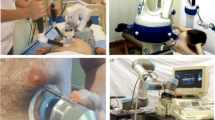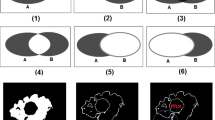Abstract
Purpose
An important issue in computer-assisted surgery of the liver is a fast and reliable transfer of preoperative resection plans to the intraoperative situation. One problem is to match the planning data, derived from preoperative CT or MR images, with 3D ultrasound images of the liver, acquired during surgery. As the liver deforms significantly in the intraoperative situation non-rigid registration is necessary. This is a particularly challenging task because pre- and intraoperative image data stem from different modalities and ultrasound images are generally very noisy.
Methods
One way to overcome these problems is to incorporate prior knowledge into the registration process. We propose a method of combining anatomical landmark information with a fast non-parametric intensity registration approach. Mathematically, this leads to a constrained optimization problem. As distance measure we use the normalized gradient field which allows for multimodal image registration.
Results
A qualitative and quantitative validation on clinical liver data sets of three different patients has been performed. We used the distance of dense corresponding points on vessel center lines for quantitative validation. The combined landmark and intensity approach improves the mean and percentage of point distances above 3 mm compared to rigid and thin-plate spline registration based only on landmarks.
Conclusion
The proposed algorithm offers the possibility to incorporate additional a priori knowledge—in terms of few landmarks—provided by a human expert into a non-rigid registration process.
Similar content being viewed by others
References
Bakalakos E, Kim J, Young D et al (1998) Determinants of survival following hepatic resection for metastatic colorectal cancer. World J Surg 22: 399–404
Fong Y, Fortner J, Sun R et al (1999) Clinical score for predicting recurrence after hepatic resection for metastatic colorectal cancer: analysis of 1001 consecutive cases. Ann Surg 230: 309–318
Abdalla E, Barnett C, Doherty D et al (2002) Extended hepatectomy in patients with hepatobiliary malignancies with and without preoperative portal vein embolization. Arch Surg 137: 675–680
Shirabe K, Shimada M, Gion T et al (1999) Postoperative liver failure after major hepatic resection for hepatocellular carcinoma in the modern era with special reference to remnant liver volume. J Am Coll Surg 188: 304–309
Shoup M, Gonen M, D’Angelica M et al (2003) Volumetric analysis predicts hepatic dysfunction in patients undergoing major liver resection. J Gastrointest Surg 7: 325–330
Vauthey J, Chaoui A, Do K et al (2000) Standardized measurement of the future liver remnant prior to extended liver resection: methodology and clinical associations. Surgery 127: 512–519
Redaelli C, Wagner M, Krahenbuhl L et al (2002) Liver surgery in the era of tissue-preserving resections: early and late outcome in patients with primary and secondary hepatic tumors. World J Surg 26: 1126–1132
Selle D, Preim B, Schenk A, Peitgen HO (2002) Analysis of vasculature for liver surgical planning. IEEE Trans Med Imaging 21(11): 1344–1357
Lang H, Radtke A, Hindennach M, Schroeder T, Fruhauf NR, Malago M et al (2005) Impact of virtual tumor resection and computer-assisted risk analysis on operation planning and intraoperative strategy in major hepatic resection. Arch Surg 140(7): 629–638
Cash DM, Miga MI, Glasgow SC, Dawant BM, Clements LW, Cao Z et al (2007) Concepts and Preliminary Data Toward the Realization of Image-guided Liver Surgery. J Gastrointest Surg 11(7): 844–859
Birth M, Kleemann M, Hildebrand P, Bruch HP (2004) Intraoperative online navigation of dissection of the hepatical tissue—a new dimension in liver surgery. In: CARS, pp 770–774
Beller S, Hünerbein M, Eulenstein S, Lange T, Schlag P (2007) Feasibility of navigated resection of liver tumors using multiplanar visualization of intraoperative 3D ultrasound data. Ann Surg 246(2): 288–294
Beller S, Hünerbein M, Lange T, Eulenstein S, Gebauer B, Schlag PM (2007) Image-guided surgery of liver metastases by 3D ultrasound-based optoelectronic navigation. Brit J Surg 94(7): 866–875
Roche A, Pennec X, Malandain G, Ayache N (2001) Rigid registration of 3-D ultrasound with MR images: a new approach combining intensity and gradient information. IEEE Trans Med Imaging 20(10): 1038–1049
Slomka PJ, Mandel J, Downey D, Fenster A (2001) Evaluation of voxel-based registration of 3-D power Doppler ultrasound and 3-D magnetic resonance angiographic images of carotid arteries. Ultrasound Med Biol 27(7): 945–955
Porter BC, Rubens DJ, Strang JG, Smith J, Totterman S, Parker KJ (2001) Three-dimensional registration and fusion of ultrasound and MRI using major vessels as fiducial markers. IEEE Trans Med Imaging 20(4): 354–359
Penney GP, Blackall JM, Hamady MS, Sabharwal T, Adam A, Hawkes DJ (2004) Registration of freehand 3D ultrasound and magnetic resonance liver images. Med Image Anal 8(1): 81–91
Lange T, Eulenstein S, Hünerbein M, Schlag PM (2003) Vessel-based non-rigid registration of MR/CT and 3D ultrasound for navigation in liver surgery. Comput Aided Surg 8(5): 228–240
Lange T, Eulenstein S, Hünerbein M, Lamecker H, Schlag P (2004) Augmenting intraoperative 3D ultrasound with preoperative models for navigation in liver surgery. In: Barillot C, Haynor D, Hellier P (eds) Medical image computing and computer-assisted intervention. Lecture notes in computer science, vol 3217. Springer, Berlin, pp 534–541
Reinertsen I, Lindseth F, Unsgaard G, Collins D (2007) Clinical validation of vessel-based registration for correction of brain-shift. Med Image Anal (in press)
Reinertsen I, Descoteaux M, Siddiqi K, Collins D (2007) Validation of vessel-based registration for correction of brain shift. Med Image Anal 11(4): 374–388
Aylward SR, Jomier J, Weeks S, Bullitt E (2003) Registration and analysis of vascular images. Int J Comput Vision 55(2–3): 123–138
Lange T, Lamecker H, Hünerbein M, Eulenstein S, Beller S, Schlag P et al (2007) A distance measure for non-rigid registration of geometrical models to intensity data. In: Lemke H et al (eds) CARS, vol 2 (Supp 1) of International Journal of Computer Assisted Radiology and Surgery. Springer, Berlin, pp 204–206
Haber E, Modersitzki J (2004) Numerical methods for volume preserving image registration. Inverse Probl 20: 1621–1638
Modersitzki J (2007) Image registration with local rigidity constraints. In: Bildverarbeitung für die Medizin, pp 444–448
Gobbi D, Comeau R, Peters T (2000) Ultrasound/mri overlay with image warping for neurosurgery. In: Medical Image Computing and Computer-Assisted Intervention (MICCAI). Springer, Berlin, pp 106–114
Bookstein FL (1989) Principal warps: thin-plate splines and the decomposition of deformations. IEEE Trans Pattern Anal Mach Intell 11(6): 567–585
Rohr K (2001) Landmark-based image analysis. Springer, Berlin
Modersitzki J (2004) Numerical methods for image registration. Oxford University Press, Oxford
Davis MH, Khotanzad A, Flaming DP, Harms SE (1997) A physics-based coordinate transformation for 3-D image matching. IEEE Trans Med Imaging 16(3): 317–328
Kohlrausch J, Rohr K, Stiehl HS (2005) A new class of elastic body splines for nonrigid registration of medical images. J Math Imaging Vis 23: 253–280
Rohr K, Stiehl H, Sprengel R, Buzug T, Weese J, Kuhn M (2001) Landmark-based elastic registration using approximating thin-plate splines. IEEE Trans Med Imag 20(6): 526–534
Wörz S, Rohr K (2006) Physics-based elastic image registration using splines and including landmark localization uncertainties. In: MICCAI (2), pp 678–685
Papenberg N, Lange T, Modersitzki J, Schlag PM, Fischer B (2008) Image registration for CT and intra-operative ultrasound data of the liver. In: SPIE Medical imaging: visualization, image-guided procedures, and modeling, vol 6918 (accepted)
Fischer B, Modersitzki J (2003) Combining landmarks and intensity driven registrations. In: PAMM Proceedings in Applied Mathematics and Mechanics. vol 3, pp 32–35
Fischer B, Modersitzki J (2003) Combination of automatic non-rigid and landmark based registration: the best of both worlds. In: Sonka M, Fitzpatrick J (eds) Medical imaging 2003: image processing. Proceedings of the SPIE 5032, vol 5032, pp 1037–1048
Haber E, Modersitzki J (2007) Intensity gradient based registration and fusion of multi-modal images. Methods Inf Med 46(3): 292–299
Fischer B, Modersitzki J (2003) FLIRT: a flexible image registration toolbox. In: Gee J, Maintz J, Vannier M (eds) 2nd International Workshop on Biomedical Image Registration 2003, vol 2717. Springer, Berlin, pp 261–270
Papenberg N, Schumacher H, Heldmann S, Wirtz S, Bommersheim S, Ens K et al (2007) A fast and flexible image registration toolbox—design and implementation of the general approach. Bildverarbeitung für die Medizin 2007. Informatik Aktuell, pp 106–110
Broit C (1981) Optimal registration of deformed images. Department of Computer and Information Science, University of Pennsylvania
Haber E, Modersitzki J (2006) A multilevel method for image registration. SIAM J Sci Comput 27(5): 1594–1607
Modersitzki J (2008) FLIRT with rigidity—image registration with a local non-rigidity penalty. Int J Comput Vis 76(2): 153–163
Wahba G (1990) Spline models for observational data. SIAM, Philadelphia
Nocedal J, Wright SJ (1999) Numerical optimization. Springer, Berlin
Lange T, Wenckebach T, Lamecker H, Seebass M, Hünerbein M, Eulenstein S et al (2005) Registration of different phases of constrast-enhanced CT/MRI data for computer-assisted liver surgery planning: Evaluation of state-of-the-art methods. Int J Med Robot Comput Assist Surg 1(3): 6–20
Christensen G, Geng X, Kuhl J, Bruss J, Grabowski T, Pirwani I et al (2006) Introduction to the non-rigid image registration evaluation project (NIREP). In: WBIR. Lecture notes in computer science, vol 4057. Springer, Berlin, pp 128–135
Lange T, Lamecker H, Hünerbein M, Eulenstein S, Beller S, Schlag PM (2008) Validation metrics for non-rigid registration of medical images containing vessel trees. In: Bildverarbeitung für die Medizin (BVM), pp 82–86
Author information
Authors and Affiliations
Corresponding author
Rights and permissions
About this article
Cite this article
Lange, T., Papenberg, N., Heldmann, S. et al. 3D ultrasound-CT registration of the liver using combined landmark-intensity information. Int J CARS 4, 79–88 (2009). https://doi.org/10.1007/s11548-008-0270-1
Received:
Accepted:
Published:
Issue Date:
DOI: https://doi.org/10.1007/s11548-008-0270-1




